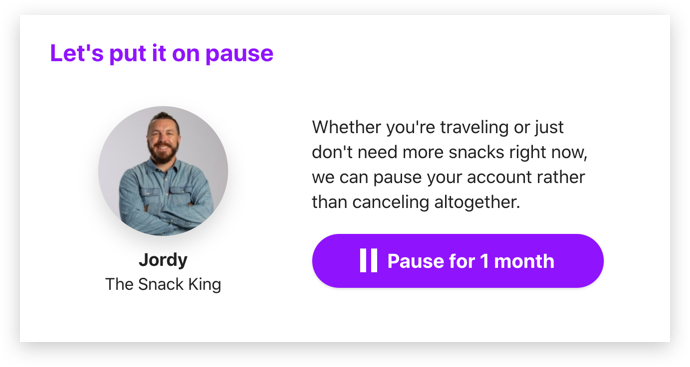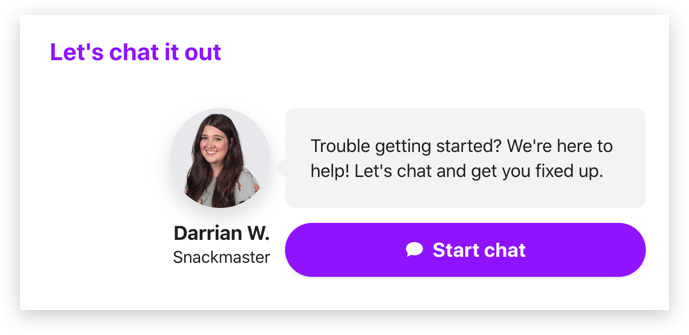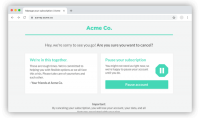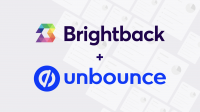6 ways to retain subscribers before they cancel


Thousands of cancels a day. Hundreds of concurrent tests. And counting. That’s the data we’re working with at Brightback as we monitor and deflect cancellations for subscription businesses in e-commerce, SaaS, media and more.
At the moment of cancel, subscribers can be retained. By offering relevant solutions in the moment, subscription companies can save double digits of subscribers before they cancel. So, how should companies think about their offer strategy? We’ve identified six categories of offers that companies can use to solve their customer needs and extend LTV. How you deploy different types of offers will depend on the characteristics of your customers and the problems that are causing them to leave your subscription service.
Save offer categories:
- Discounts
- Pauses
- Plan changes
- Extensions
- Support & training
- Customer feedback
A quick note on incentives: We classify offer categories as either incentive based or non-incentive based. An incentive-based offer means something is being given to retain a subscriber. These offers are more likely to save subscribers. However, incentive-based offers come with a cost, and should be deployed thoughtfully.
Discounts
Discounts are a great tool for pushing sales deals over the line, but they can also be utilized to retain customers before they cancel. Generally, discounts offered are either percentage or dollar-based. Brightback customers tweak discount offers to fit their pricing and packaging strategy. We’ve found these incentive-based offers perform well with price sensitive subscribers, particularly for direct-to-consumer (D2C) subscription businesses.

Where should you start with a discount? Experiment with percentage discounts ranging from 10-50%. We find the sweet spot is between 15-30%—the user is adequately incentivised to accept a cheaper price, but the brand is not forgoing too much value. These ranges will vary depending on the service or good, so we recommend testing how offer accept rates change based on the strength or type of discount you offer to optimize for the highest LTV.
Pauses
Pauses are an extremely popular offer type for subscription companies, particularly among D2C businesses and B2B subscriptions with a cyclical usage pattern. Regardless of the company, it’s easy for subscribers to grasp what a pause will mean for their account. We see pause offers have some of the highest offer accept rates ranging from 10% - 30% depending on the subscription type.
Companies may refer to pause offers as “skips” or “plan archives”. Either way, they’re referring to the ability of a subscriber to suspend payment for a period of time. This offer type isn’t new and goes back to the early subscription days of newspapers and magazines.

Two things to consider when determining how to deploy pause offers:
First, what is the duration of the pause? Keep in mind that the longer the Pause duration, the greater the incentive but also the higher the cost of the offer.
Second, what is the re-subscribe rate of the subscriber after pausing? The resubscribe rate coupled with the cost of the offer can be used to establish the optimal pause duration.
Plan changes
Plan changes is an often overlooked, yet powerful, offer. Many of your subscribers aren’t dissatisfied with your product as a whole, but are simply on the wrong plan or package for their needs. These subscribers can often be saved with a targeted plan change offer. Here are a few examples of types of plan changes we’ve seen deployed via Brightback:
- Upgrades (lower-tier to higher-tier, typically at a discount or no price change)
- Downgrades (higher-tier to lower-tier)
- Term changes (monthly > annual or annual > monthly)
- Bundles (switch from bundle A to bundle B)
Subscribers may want to downgrade to a lower tier product and give up an unnecessary feature. Or they may want to swap from another order of underwear to a sock or pajama subscription. Maybe a subscriber doesn’t need 8 meals this week since they’re spending more time at home, so they can switch easily to a 4 meal plan. Or, instead of an annual plan, they’re practicing being more budget conscious and would like a monthly subscription instead.
These use cases demonstrate you can still save subscribers and some of their revenue by meeting needs head on at the moment of cancel. Of course, the tricky part is identifying which users are ripe for a plan change. At Brightback, we have strategies to test offers and identify the optimal combination of offers to retain subscribers, and plan changes are one of the best categories for rapid testing.
Extensions
Extensions are similar to the pauses, but have slight nuances that make them distinct. An extension refers to any time you push out the renewal date on a subscription or extend a “free month” to the customer as a courtesy. These offers typically make the most sense in a B2B setting where you may grant customers certain exceptions to the typical billing process or in a trial-based plan where the user is not yet ready to be charged for the first time.

Extensions are best deployed when you’re on the path to delivering value, but have had a few hiccups along the way. For example, maybe the onboarding process took longer than expected, and the customer did not get the initial value they expected until a month later; this would be an opportunity to provide the user with a free month as a credit for lost time. Or perhaps your trial process is complex and users get stuck frequently and need more time to make a purchase decision. We’ve found that a well placed extension can convert future renewals or trial subscribers into revenue.
Support & training
Support & training is by far the broadest offer category with the widest range of acceptance rates. It’s difficult to establish benchmarks for this category, because educational content and resources being contextual to the product and customer base.
Generally, we see support or educational offers perform worse than incentive-based offers, but they come at a far lower cost. If you have a product that requires some nudges to get the user to full adoption, this can be a great offer to try.
A few examples:
- A well placed educational video explaining the value proposition of the product (specifically for D2C companies with a strong brand).
- Chat with an agent (works best when the issue is immediately addressable).
- See our features/roadmap (works best for longer tenured customers who may not know about the latest and greatest).
- Schedule a free training session with an onboarding specialist (for complex products that require help setting up).

When it comes to thinking about what support & training offers to test, consider who your subscriber is and the reasons they’re leaving. If you think those reasons can be addressed with this offer category, then test away. But don’t overestimate the power of your content to save a subscriber who has already had a chance to see it.
Customer feedback
This final offer category represents a learning opportunity more than a true driver of retention. It’s difficult to save a subscriber who tells you the product doesn’t have the features they need, but this is a great opportunity to learn from the experience.
We’ve seen these questions used effectively to gather product feedback for upstream improvements or to trigger future win-back campaigns:
- If you had one wish, what would it be?
- What feature/functionality would change your mind?
- What can we do to make this right?
- What about our product don’t you like?

While the goal is not necessarily to save the subscriber, this is still an offer category because it gives you the opportunity to engage the subscriber one last time before they complete cancellation.
Categorize, then optimize
The key to a successful offer strategy is to give up just enough to retain subscribers while optimizing for incremental LTV. If you're just starting out with building your cancel experience, these six offer categories are a great framework to build upon. If you’ve been saving customers at the point of cancel already, consider streamlining your strategy into offer categories so you can get a true measure of performance.
Want to talk? We’d love to show you how Brightback’s testing methodology can help get you there faster.



